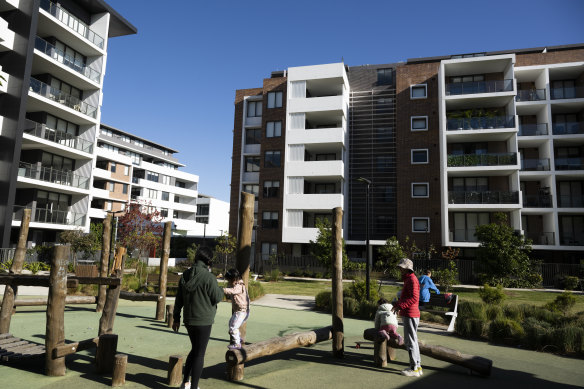Editorial
Behaviour of major building industry players under scrutiny
For most Australians, buying a home is the biggest purchase of their lives. Years of saving, scrimping for a deposit and weekends spent hunting for just the right place.
While prospective homeowners have to jump through endless hoops to have their financial affairs in order, the effectiveness of the regulatory environment governing builders and developers who take customer money to build the dream homes is again under scrutiny.

Park Grove development in Botany by Toplace where defects have been found. Credit: Louise Kennerley
As the tide goes out on post-pandemic era cheap financing, developers are coming under financial pressure, and more problems are beginning to emerge around the behaviour of significant industry players.
The appointment of a NSW building commissioner in 2019 was an acknowledgment by the then-government of concerns surrounding the quality of projects in an industry that was delivering disasters such as the Opal Tower which saw hundreds of residents evacuated.
Taking a stand against dodgy developers and private certifiers, often on the payroll of the developers who turned a blind eye to defects were paid to sign off on questionable projects went some way to taking a stand against some of the most acute problems.
As NSW building commissioner David Chandler wrote in these pages recently, coverage of the worst apartment developers and builders over the past 15 years has wreaked havoc on public confidence.
“Their legacy is a swath of appalling buildings riddled with complex challenges, and innocent homeowners inhabiting a world of pain,” Chandler wrote.
On the one hand Chandler acknowledges the impact of troubled players like Merhis, Dyldam, Ralan Group, Toplace, Southern Cross Constructions and Australian Consulting Engineers (ACE) and their continued tarnishing of confidence in the industry.
But on the other he is keen to stress a steadily growing number of trustworthy developers and builders taking a firm stand to distance themselves from those who have left a trail of dodgy buildings behind.
What gives the Herald pause for thought is that the NSW government has called for a substantial lift in the number of new apartment buildings to address the chronic shortage of housing, and confirmed the state is seeking both “quality and quantity”.
The Herald finds itself backing the need to increase development in some areas of Sydney in particular to provide affordable housing and opportunity for essential workers close to major economic hubs. Developers who are both responsible and profitable are part of that picture.
Yet there are disturbing examples emerging of the behaviour of some developers. The collapse of the Toplace empire run by fugitive Jean Nassif is a case in point. Nassif has been accused of fraud relating to a $150m loan from Westpac that was obtained using fraudulent pre-sale documents for an apartment complex in Castle Hill.
The case highlights the awful reality facing customers in dealing with the expanding problems in the industry. Creditors have already lined up to claim more than $600 million in funds from the crippled builder in what shapes as the biggest administration of a developer in Australia.
What about the people who’ve bought into these buildings? Who is doing anything for them? Prospective homebuyers who have poured their life savings into projects and taken on significant debt to fund purchases face being left with a complicated path to recompense.
And as we build bigger projects in a more densely populated environment, developers and their projects are getting bigger. These are not projects affecting 20 people with a small home builder but can be as many as 500 people in a building.
Already standing in line in any administration or liquidation will be queues of tradies, suppliers and contractors already out of pocket on the project.
Who is going to be left carrying the can for the repair of defects in a world where developers go under? For finishing projects? For honouring contracts worth more than the dollars and cents of hopeful home buyers but also the hopes and dreams?
Sure, the buyer must beware. But regulation must be effective. The industry has been plagued by phoenixing for years, where dodgy developers avoid ongoing costs by putting companies into administration, only for the key players to emerge in a fresh guise with a new name.
But when the numbers affected escalates at a time of economic difficulty, a fresh challenge presents itself for policymakers and regulators.
There will be little appetite for taxpayers to be on the hook as the pressure builds for elected officials to step in. Does this leave every prospective homeowner on the hook?
As Chandler knows in the complicated world of building construction, there is more to do. Policymakers may soon be about to find that out too.
Bevan Shields sends an exclusive newsletter to subscribers each week. Sign up to receive his Note from the Editor.